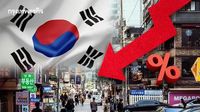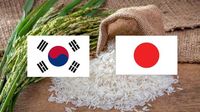On April 21, 2025, South Korea announced a significant development in its trade relations with Japan, marking the first import of rice from South Korea to Japan since 1999. This move comes amid a domestic rice price crisis in Japan, which has seen prices soar, increasing demand for foreign rice despite high import tariffs. The rice trade between the two nations is occurring at a time when both are working to strengthen their economic ties in response to U.S. trade policies.
The rice was imported through the National Agricultural Cooperative Federation (NACF) of Japan, with two tons of South Korean rice being sold through online channels and local supermarkets. This marks a historic moment, as it is the first sale of South Korean rice in Japan since the NACF established its presence there. While this quantity is modest compared to Japan's total rice consumption, it signals a positive step for South Korean exports, which are under pressure from U.S. trade policies.
According to a representative from the NACF, South Korean rice has struggled to compete in the Japanese market due to high import tariffs. However, the initial two tons have sold out, and plans are in place to ship an additional 20 tons within the week, marking the largest shipment in 35 years. Data from Japan’s Ministry of Internal Affairs indicates that rice prices in Japan surged by 92% in March 2025 compared to the same month last year, the fastest increase since records began in 1974, contributing to rising inflation.
In a separate report, the Thai Hom Mali Rice Exporters Association revealed that Thailand has been exporting rice since 1999, making it a leading rice exporter. The association noted that Thai Hom Mali rice is gaining traction in international markets, particularly in China and Japan, which are crucial customers. Despite facing challenges from higher production costs, the Thai government is promoting its rice exports, preparing to compete in the global market.
On the same day, data from the South Korean Customs Service revealed that the country’s exports dropped by 5.2% in the first 20 days of April, with exports to the U.S. plummeting by 14.3%. This decline is attributed to the ongoing trade war initiated by President Donald Trump, who has imposed reciprocal tariffs on various goods, including a 25% tariff on automobiles that took effect on April 3, 2025.
Exports to China also fell by 3.4%, but exports to the European Union (EU) rose by 13.8%. Notably, while automobile exports decreased by 6.5%, semiconductor exports increased by 10.7%. The overall decline in exports reflects the broader challenges faced by South Korean businesses as they navigate the complexities of international trade relations.
In another concerning trend, South Korean customs officials reported an increase in counterfeit goods being labeled as South Korean products to evade U.S. tariffs. In the first quarter of 2025, the total value of these violations reached 29.5 billion won (approximately $964 million), with 97% of these cases linked to exports to the U.S. This situation underscores the heightened scrutiny and regulatory challenges faced by South Korean exporters.
Additionally, the South Korean Customs Service has established a special task force to address illegal export practices and is planning to implement clearer measures to protect domestic companies from such fraudulent activities.
In the backdrop of these trade tensions, gold prices have been on the rise, hitting record highs as investors flock to gold as a safe-haven asset amid escalating trade conflicts. In South Korea, daily gold trading volumes have surged more than threefold, reflecting growing investor interest. Spot gold prices have risen by 26% since the beginning of the year, hovering around $3,357 per ounce.
Despite a slight decrease in local gold prices from a peak of 170,000 won per gram in February, the market remains optimistic about gold's future. Analysts suggest that if trade tensions persist, the uncertainty will likely drive gold prices even higher. Financial institutions have adjusted their price forecasts, with Goldman Sachs projecting gold prices could reach $3,700 per ounce and UBS predicting a target of $3,500 per ounce.
The interplay of these economic factors—from rice exports to gold pricing—illustrates the interconnectedness of global trade and the significant impact of U.S. trade policies on South Korea and its trading partners. As countries like South Korea and Thailand adjust their strategies in response to these challenges, the global market dynamics continue to evolve.
As the situation develops, stakeholders in the agricultural and export sectors are closely monitoring these trends, seeking to capitalize on opportunities while navigating the complexities of international trade. The coming months will be critical for these nations as they adapt to the shifting landscape of global commerce.







